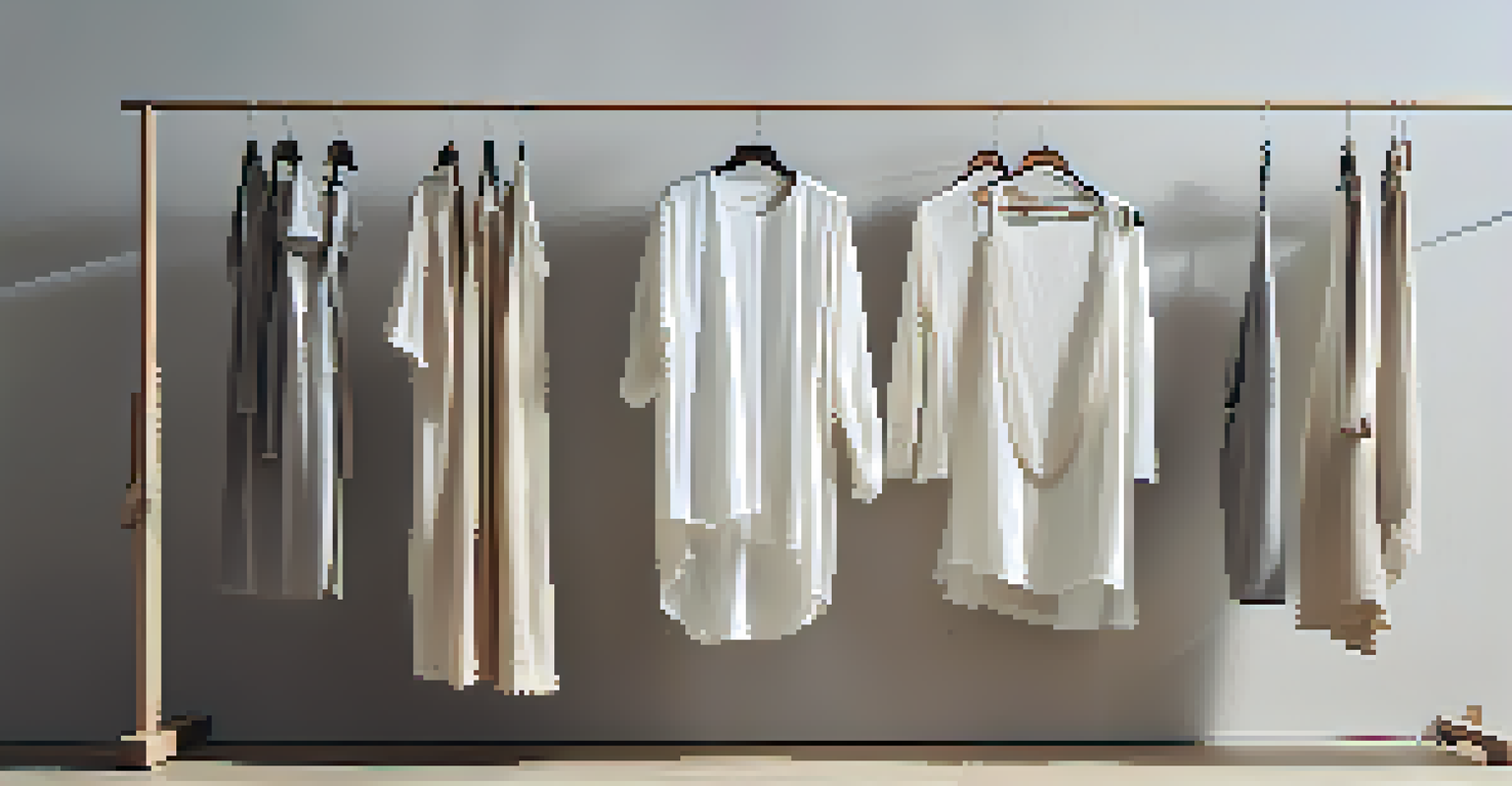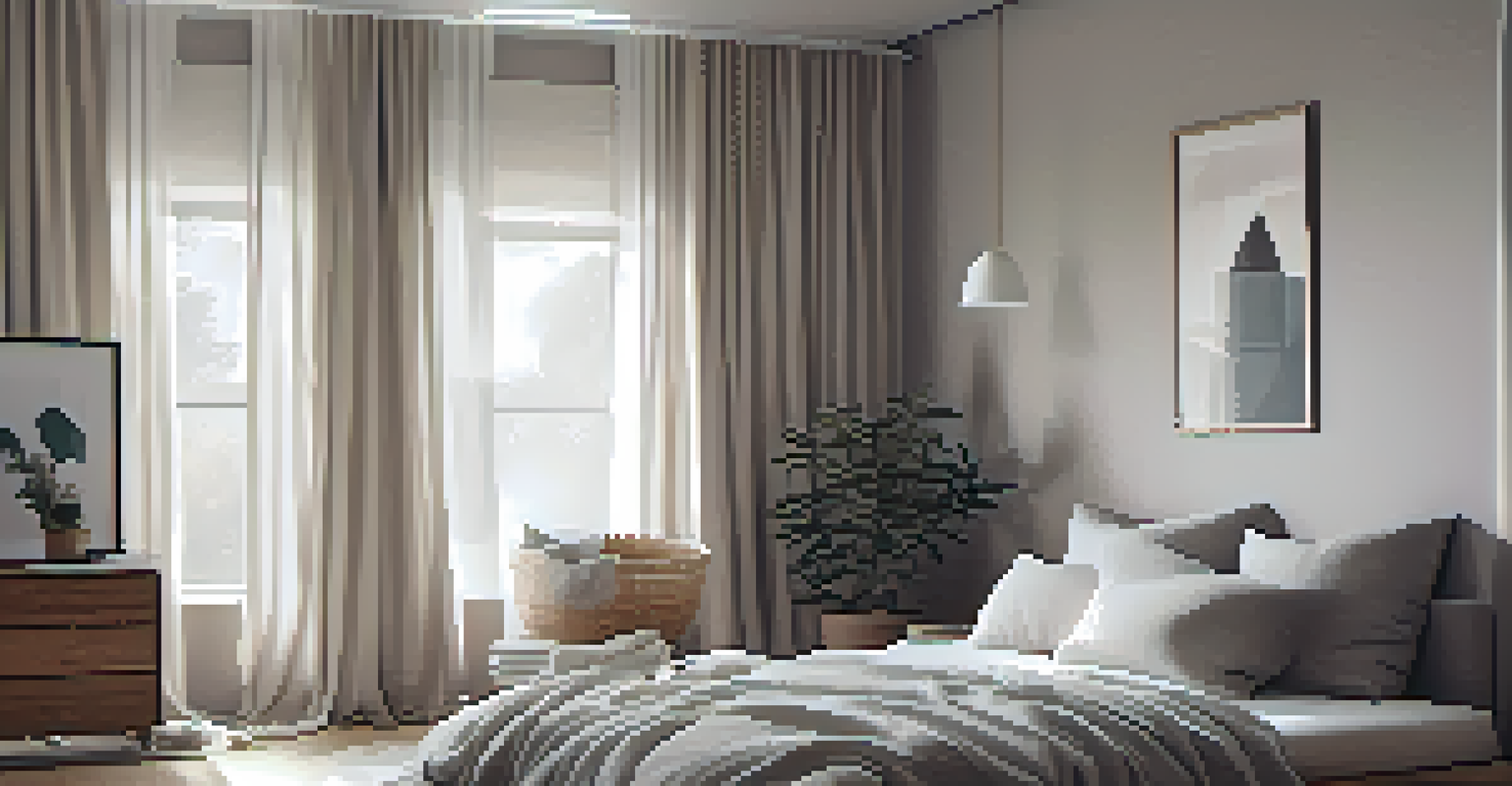The Evolution of Minimalist Fashion in Recent Years

Understanding Minimalist Fashion: A Brief Overview
Minimalist fashion is all about simplicity and functionality, focusing on clean lines and a restrained color palette. It encourages individuals to curate a wardrobe filled with versatile pieces rather than an overwhelming number of items. This approach not only promotes a more sustainable fashion choice but also fosters creativity in styling.
Simplicity is the ultimate sophistication.
Historically, minimalist fashion emerged in the 1960s and gained traction in the 1990s, but recent years have seen a resurgence, driven by a collective desire for less clutter and more quality. Consumers are increasingly drawn to brands that prioritize ethical production and timeless designs. The rise of social media has also played a significant role in showcasing minimalism as a lifestyle choice.
In essence, minimalist fashion is not just about the clothes we wear; it’s a reflection of a mindset that values quality over quantity. This philosophy resonates with many, leading to a broader acceptance and appreciation of minimalist aesthetics in everyday life.
Key Influences Behind Minimalist Fashion's Resurgence
Several factors have contributed to the resurgence of minimalist fashion, including the rise of eco-consciousness among consumers. As more people become aware of the environmental impact of fast fashion, they seek sustainable alternatives that align with their values. Minimalist brands often emphasize ethical sourcing and production practices, attracting a dedicated following.

Additionally, the influence of social media and fashion influencers cannot be overstated. Platforms like Instagram and Pinterest have made it easier for minimalism advocates to share their style tips and outfit inspirations. This has created a community that celebrates the beauty of simplicity, encouraging others to adopt a minimalist approach.
Minimalist Fashion Emphasizes Quality
Minimalist fashion promotes a wardrobe of versatile, high-quality pieces over an overwhelming quantity of items.
Lastly, the COVID-19 pandemic has prompted many to reevaluate their lifestyles, leading to a shift towards comfort and practicality. As people spent more time at home, they gravitated towards versatile and easy-to-wear pieces, cementing minimalism as a preferred choice in fashion.
The Role of Sustainable Practices in Minimalist Fashion
Sustainability is at the heart of the minimalist fashion movement, driving brands to adopt eco-friendly practices. This includes using organic materials, reducing waste, and ensuring fair labor practices. Many minimalist brands focus on creating timeless pieces that can be worn for years, rather than fleeting trends that quickly go out of style.
Fashion is about dressing according to what’s fashionable. Style is more about being yourself.
For instance, brands like Everlane and Reformation have made waves in the industry by prioritizing transparency in their production processes. They educate consumers about the environmental impact of their purchases, building a community of informed buyers. This commitment to sustainability not only enhances brand loyalty but also encourages consumers to embrace a more mindful approach to their fashion choices.
Ultimately, the fusion of minimalism and sustainability is reshaping the fashion landscape, encouraging both brands and consumers to make responsible decisions. This shift not only benefits the planet but also nurtures a culture of appreciation for quality over quantity.
Iconic Minimalist Fashion Designers and Brands
Several designers and brands have become synonymous with minimalist fashion, shaping its evolution over the years. Names like Calvin Klein and Jil Sander have long been celebrated for their clean silhouettes and understated aesthetics. Their work has paved the way for a new generation of designers who continue to push the boundaries of minimalism.
Emerging brands such as Aritzia and COS have also made significant contributions, offering chic and functional pieces that embody minimalist principles. Their collections often feature neutral colors and simple designs, appealing to a broad audience seeking simplicity in their wardrobes. These brands have successfully tapped into the growing demand for sustainable and ethical fashion.
Sustainability Drives Minimalism's Rise
The shift towards eco-consciousness has led consumers to seek sustainable brands that prioritize ethical practices.
In addition to established names, many indie designers are embracing minimalism, showcasing their work through online platforms. This democratization of fashion allows for diverse interpretations of minimalism, enriching the overall narrative and inspiring consumers to explore their unique style.
Minimalist Fashion in Pop Culture and Media
Minimalist fashion has found a prominent place in pop culture and media, influencing how we perceive style and beauty. From iconic films showcasing minimalist wardrobes to fashion magazines highlighting simple yet elegant designs, minimalism has permeated various aspects of our lives. This cultural shift has made it more mainstream and relatable.
Celebrities and influencers often embrace minimalist looks, showcasing how less can be more. When public figures like Meghan Markle and Emma Watson sport understated outfits, it reinforces the idea that simplicity is not only chic but also aspirational. Their choices inspire fans to adopt similar styles, contributing to the popularity of minimalist fashion.
Moreover, the rise of platforms like TikTok has given birth to new trends within the minimalist fashion sphere. Users share their personal takes on minimalist outfits, encouraging a fresh perspective on how to style basic pieces creatively. This constant exchange of ideas keeps the minimalist movement vibrant and relevant.
The Intersection of Technology and Minimalist Fashion
Technology is playing a significant role in the evolution of minimalist fashion. Online shopping has made it easier for consumers to find and purchase quality minimalist pieces from the comfort of their homes. E-commerce platforms allow brands to reach a wider audience, showcasing their designs without the constraints of traditional retail.
Additionally, advancements in fabric technology have led to the creation of innovative materials that align with minimalist principles. Brands are now able to produce clothes that are not only stylish but also functional and durable, enhancing the appeal of minimalist fashion. This fusion of technology and design is helping to create a new wave of sustainable, fashionable options.
Technology Shapes Minimalist Trends
Advancements in technology are enhancing the appeal of minimalist fashion through innovative materials and efficient wardrobe management.
Furthermore, technology enables consumers to curate their wardrobes more efficiently through apps and platforms dedicated to minimalist living. These tools help individuals track their clothing, suggest outfit combinations, and encourage a thoughtful approach to fashion consumption. This intersection of technology and minimalism is reshaping how we engage with our wardrobes.
Future Trends in Minimalist Fashion
As minimalist fashion continues to evolve, we can expect to see several emerging trends that will shape its future. One significant trend is the integration of smart technology into clothing, allowing for a seamless blend of style and functionality. Imagine a wardrobe where your clothes keep you comfortable while looking effortlessly chic!
Another trend is the continued emphasis on personalization within the minimalist framework. Consumers are seeking unique pieces that reflect their personal style while maintaining the principles of minimalism. Brands that offer customizable options or limited-edition collections will likely attract a loyal following.

Lastly, the dialogue around inclusivity in fashion is gaining momentum, and minimalist brands are beginning to embrace this shift. By creating size-inclusive and diverse collections, these brands can ensure that minimalism is accessible to everyone. This evolution not only enriches the minimalist aesthetic but also fosters a more inclusive fashion community.